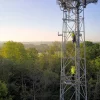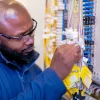Genesis Technical Systems Prep 400Mbps DSL Rings Broadband Tech for 2013
Canadian firm Genesis Technical Systems (GTS) has today announced the official launch of its patented DSLRings technology, which could deliver superfast broadband speeds of up to 400Mbps (Megabits per second) into UK homes that reside further away from their BT street cabinet than FTTC can currently reach.
ISPreview.co.uk first reported on the technology in 2010 (here and here). Since then the UK government’s Technology Strategy Board (TSB) has awarded GTS with a SMART grant worth £250,000 to help develop and trial the technology (here).
Advertisement
The technology itself is similar to BT’s Fibre-to-the-Cabinet (FTTC) solution, which uses existing copper lines and VDSL2 to deliver the “last mile” of connectivity into homes, but works by utilising two copper pairs instead of one (i.e. bonding two phone lines) to deliver faster speeds at a lower power, lower cost and even “over long distances“.
Stephen Cooke, Genesis President & CTO, said:
“DSL Rings facilitates Telco customer acquisition, win-back and retention by offering better, faster services; more bandwidth; and lower unit cost (per Mb/s) than current methods of delivering broadband services over copper.”
As usual readers should take such claims with a big pinch of salt since solutions like this have a habit of delivering well below what they promise once introduced into a real-world environment. On the other hand DSL Rings have perked the interest of more than a few national telecoms operators around Europe, such as BT in the UK, which see it as a potentially affordable alternative to FTTH/P.
Meanwhile Alcatel-Lucent, which also has strong ties to BT, have already launched a commercial alternative that uses vectoring (here) to help reduce interference and boost coverage / speeds. This is similar to DSL Rings but whether or not it’s a better solution for BT remains to be seen.
The technology is currently being put through its paces via a series of field trials, at least one of which will be conducted in the UK and involve BT’s infrastructure. GTS confirmed today that its final commercial solution would be ready in Q2-2013 (Spring).
Advertisement
Mark is a professional technology writer, IT consultant and computer engineer from Dorset (England), he also founded ISPreview in 1999 and enjoys analysing the latest telecoms and broadband developments. Find me on X (Twitter), Mastodon, Facebook, BlueSky, Threads.net and Linkedin.
« Virgin Media UK Boost Superfast 100Mbps Broadband Customers to 120Mbps
















































Comments are closed